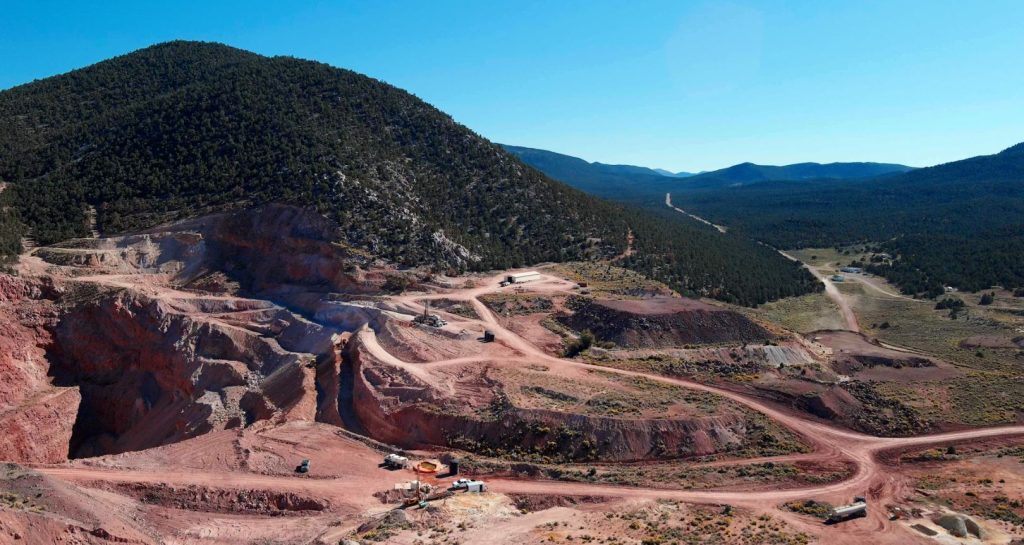Nevada King Gold drills 5.64 g/t gold over 42.8 metres at Atlanta mine project, Nevada

Nevada King Gold Corp. [NKG-TSXV; NKGFF-OTCQX] released assay results from nine vertical reverse circulation (RC) holes recently completed at its 100%-owned Atlanta gold mine project, located 264 km northeast of Las Vegas, Nevada, in the prolific Battle Mountain trend. Holes reported today along Section 22-15N were drilled north of the Atlanta pit in order to test the grade and thickness of mineralized fault blocks comprising the Atlanta Mine Fault Zone (AMFZ) and the West Atlanta Graben moving northward toward the North Extension Target zone.
Selected highlights: AT23WS-22 (5.64 g/t Au over 42.8m including 28.5 g/t over 7.6m) is located 290 metres northwest of the Atlanta pit and is interpreted to be close to true width where the high-grade gold mineralization is consistent throughout the 7.6-metre interval. DHRI-11-NRC04 is the only historic drill hole located in this area (15m to the northeast), intercepting 1.49 g/t over 42.7 metres, including 4.01 g/t gold over 13.7 metres, but with no single sample interval exceeding 8.62 g/t gold. No other holes have been drilled in the immediate vicinity of this intercept, leaving the area around this high-grade discovery open for follow on step-out drilling.
Hole AT23WS-5C (1.08 g/t Au over 112.7m) intercepted a thick zone of gold mineralization west of the West Atlanta Fault. Thickness in this hole is five times greater than reported in a nearby historic hole KR98-21 (1.19 g/t Au over 19.8m), which was lost in strongly fractured rock before it could fully penetrate the mineralized zone. Similarly, holes AT23WS-20 (3.04 g/t Au over 61.1m) and AT22WS-4 (2.07 g/t Au over 67.0m) exhibit stronger grades over significantly thicker intervals than nearby historic hole DHRI-11-NRC04, which reported 36.6 metres grading 1.71 g/t gold. This suggests that historic drill intercepts within the West Atlanta Graben failed to accurately reflect true thickness and grade. This comparison illustrates the need for tightly spaced holes that thoroughly penetrate the mineralized zones, and also highlights the differences in grade and thickness being encountered by Nevada King compared to many holes reported by prior operators
Additional infill drilling is needed between AT23WS-5C and AT23NS-104 in order to test extension of the thick mineralization encountered in AT23WS-5C eastward and beneath KR98-21 to the generally higher-grade mineralization proximate to the West Atlanta Fault.
Cal Herron, exploration manager, stated: “Our drill fence along Section 22-15N reveals three important features: the high-grade intercept in AT23WS-22 provides us with three well-mineralized zones along the West Atlanta and West Atlanta No. 2 Faults from which high-grades can be targeted for expansion outward into the thick, broad gold blanket that characterizes the West Atlanta Graben Target; we see the same repetition of high-angle faults and associated fault blocks that have been identified further south on lines 22-5N through 22-10N and further north on line 22-16N. We continue to see good continuity of mineralization over an area approximately 360 metres long in a N-S direction and at least 150 metres wide within the portion of the West Atlanta Graben drilled so far. Several historical holes suggest this mineralization extends further to the west and north from the area drilled to date; Nevada King’s more densely targeted vertical drilling pattern and better sample recovery has more accurately defined the spatial distribution of gold mineralization compared to historic drilling. In addition, a number of historic holes appear to have been terminated before fully testing the mineralized zones. The large disparity seen above between Kinross’ angle hole KR98-21 and Nevada King’s vertical hole AT23WS-5C is a good example of this. Other similar examples exist throughout the Gustavson 2020 resource zone and to the north in the North Extension Target, so simply re-drilling earlier holes that did not go through the mineralized zones is an important component of the company’s exploration strategy at Atlanta. Stepping out from recent discovery intervals and testing mineralization to greater depths will keep our drills busy for several months to come.
“The 7.6 metres of 28.5 g/t gold hit in AT23WS-022 represents the highest grade gold intercept exceeding 1.52 metres in length on the entire Atlanta property going back to the 1970s. This intercept occurs on the western margin of the West Atlanta Graben and is probably associated with the West Atlanta No. 2 Fault. We will certainly be positioning holes along multiple drill fence lines to intercept this structure northward and southward from Section22-15N. We’ve now hit high grades along the East Atlanta, West Atlanta, and West Atlanta No. 2 Faults, so these widely spaced occurrences beg the question, ‘How many more high grade structures will we find at Atlanta that no one knew about?’”
The company is well funded with cash of approximately $7.25 million.
